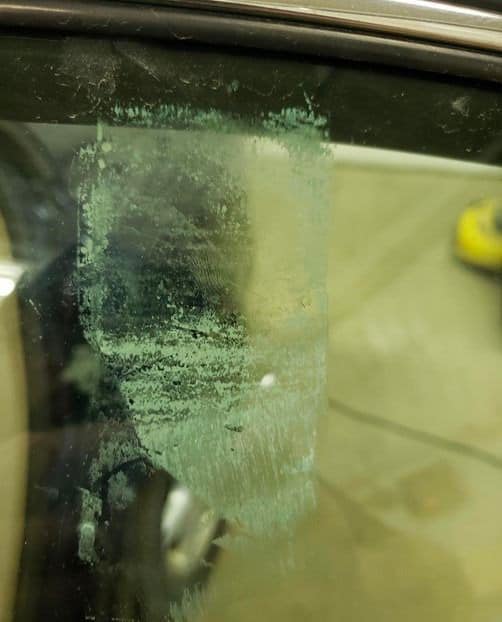ADVERTISEMENT
Steps:
- Mix equal parts white vinegar and water in a spray bottle.
- Shake the bottle to mix the solution.
- Spray the vinegar solution directly onto the sticky area and let it sit for a few minutes.
- Use a cloth or paper towel to wipe away the residue. You can also use a plastic scraper or an old credit card to gently scrape off the sticky stuff.
- Wipe the window clean with a dry cloth to remove any excess vinegar.
Method 3: Baking Soda Paste for Tough Spots
Baking soda is a mild abrasive that can help scrub away sticky residue, particularly from more stubborn spots. It also helps deodorize while cleaning.
Steps:
- Create a paste by mixing 2 tablespoons of baking soda with just enough water to make a thick consistency.
- Apply the paste directly to the sticky spot on your window.
- Let the paste sit for 5–10 minutes to allow it to work its magic.
- Using a soft cloth or sponge, gently scrub the area in circular motions.
- Wipe away the paste with a clean, damp cloth and finish by wiping the window dry with a dry cloth.
Method 4: Rubbing Alcohol for Strong Adhesives
Rubbing alcohol (isopropyl alcohol) is a powerful solvent that can break down even the most stubborn adhesive residues, such as those left by labels, tape, or glue.
Steps:
- Dampen a cotton ball, cloth, or paper towel with rubbing alcohol.
- Gently rub the sticky residue on the window until it starts to dissolve.
- You may need to apply more alcohol for stubborn spots.
- Use a plastic scraper or an old credit card to gently scrape away the remaining residue.
- Wipe the window clean with a dry cloth.
Method 5: Use a Plastic Scraper for Scraping
If you’re dealing with a particularly stubborn sticky spot, a plastic scraper can be very helpful. It’s important to use a plastic scraper to avoid scratching the glass. This method works well in combination with one of the above cleaning solutions.
Steps:
- Apply one of the cleaning solutions mentioned above (like vinegar, warm soapy water, or rubbing alcohol) to the sticky residue.
- Let it sit for a few minutes to loosen the adhesive.
- Gently scrape the residue using a plastic scraper or old credit card. Hold the scraper at a low angle to avoid damaging the window.
- After scraping, wipe away any remaining residue with a cloth and finish with a dry wipe.
Method 6: Commercial Adhesive Removers
If all else fails and you still have sticky marks on your windows, commercial adhesive removers are available that are specially designed to break down stubborn adhesives. Look for products like Goo Gone or similar brands.
Steps:
- Follow the instructions on the adhesive remover packaging.
- Apply the remover to the sticky area.
- Allow it to sit for the recommended amount of time (usually a few minutes).
- Wipe the residue away with a clean cloth.
- Finish by cleaning the window with water and wiping it dry.
Tips for Preventing Sticky Residue in the Future:
- Avoid Excessive Tape: When using tape, especially on windows, be cautious about how long you leave it on. Prolonged contact can lead to stubborn adhesive residue.
- Use Removable Labels: If you’re using labels or stickers on your windows, choose ones that are designed to peel off easily without leaving a sticky residue.
- Clean Regularly: Frequent cleaning helps prevent the buildup of dirt and residue that can eventually become harder to remove.
Conclusion: Keep Your Windows Sparkling Clean
Sticky residue on windows can be frustrating, but with these simple and effective methods, you can have your windows looking pristine in no time. From using basic household ingredients like vinegar and baking soda to stronger solutions like rubbing alcohol, there’s a method that suits every need. And by following the tips for preventing sticky residue, you’ll keep your windows spotless and free from marks in the future.
Whether you’re cleaning up after a sticker or just want to get rid of leftover adhesive, these methods will help you achieve sparkling, clear windows without a hassle!
ADVERTISEMENT
